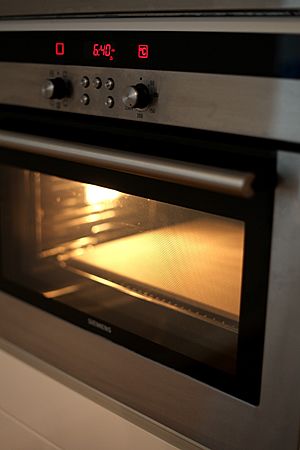Baking stone facts for kids
A baking stone is a special flat surface used for cooking in an oven. Think of it like a cookie sheet, but it's usually made from ceramic, stone, or even salt. You place food on the stone, then put it in the oven. Sometimes, the stone is heated up first before the food goes on it. Baking stones can make your food extra crispy because they soak up extra moisture. A pizza stone is a type of baking stone made especially for cooking pizza.
Contents
What is a Baking Stone?
Baking stones are great for cooking because they hold heat very well, but they don't let it go too quickly. This means your food is less likely to burn compared to cooking on metal or glass pans. Using a baking stone is a bit like "hot stone cooking," which is one of the oldest ways people have cooked food!
How to Use Your Baking Stone
To stop food from sticking, some cooks sprinkle a little cornmeal or flour on the stone. You can also use parchment paper on top of the stone. You can buy baking stones as plain ceramic tiles or special clay tiles from hardware stores.
Keeping Your Stone Safe
Baking stones can crack if they change temperature too quickly. To prevent this, always put your stone into a cold oven. Then, heat the oven slowly for at least 45 minutes. After cooking, let the stone cool down slowly inside the oven. Never leave your baking stone in the oven when it's in self-cleaning mode, as the very high heat can damage it.
Cleaning Your Baking Stone
Cleaning a baking stone is simple! Just use a dry brush or a scouring pad to scrape off any bits of food. Then, wipe it down with plain hot water. It's important not to use detergent or soap. Baking stones are porous, meaning they can soak up liquids. If you use soap, the stone will absorb it, and your food might taste like soap next time you cook!
Pizza Stones: Perfect for Pizza
When a baking stone is made for cooking pizza, it's often called a pizza stone. Using a pizza stone helps your homemade pizza taste more like it came from a fancy masonry oven (a brick oven). Many people believe the stone's porous surface soaks up moisture from the pizza dough. This helps create a super crispy crust, which is what everyone loves about pizza!
Different Kinds of Pizza Stones
You can find small pizza stones that fit perfectly into any regular cooking oven. Some are even made for outdoor barbecue grills. Some fancy ovens even come with special pizza stones designed just for them, sometimes with their own heating element! Besides traditional stone, you can also find pizza stones made from metal.
Pizza / Baking Steel
A baking steel (sometimes called a pizza steel) is a thick, flat piece of A36 steel. It's usually about 16 inches long, 16 inches wide, and 1/4 inch thick. Steel heats up and transfers heat much faster than stone. This makes it great for getting a super crispy crust on pizzas, especially when used under a broiler or on a grill.
However, because it gets so hot, a baking steel might be too powerful for delicate foods like bread, cookies, or croissants. Baking steels are heavier than stones and need to be "seasoned" before you use them. This means you put a thin layer of oil on them and bake it on, which helps prevent rust and creates a non-stick surface.



